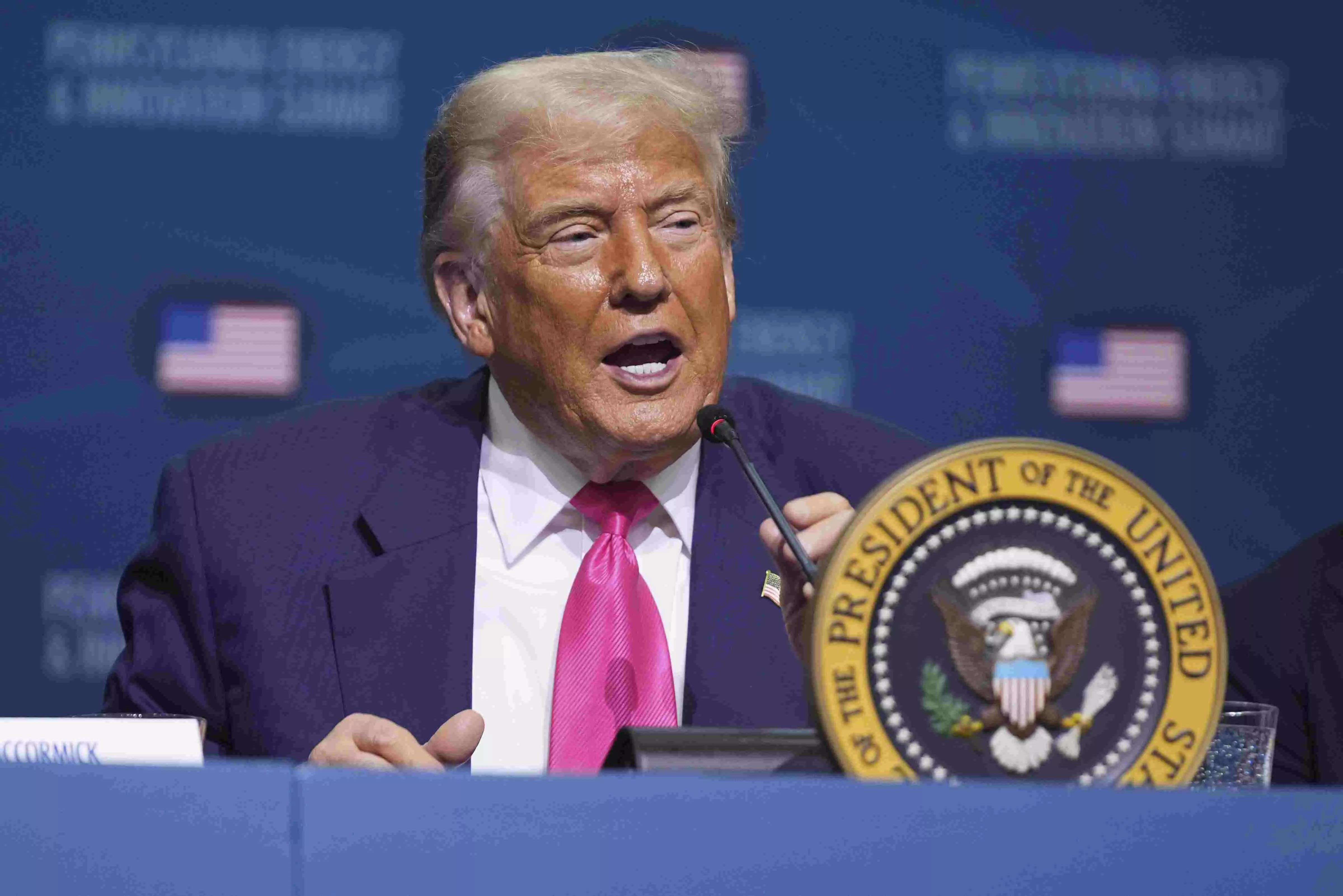Trigger for Realignment
Trump’s tariff blitz on allies may backfire, accelerating the rise of a new global power triangle—the USA, China-led BRICS, and a resurgent Europe—reshaping global trade and diplomacy

After weeks of failed negotiations with the major US trading partners to reach a comprehensive trade deal, President Donald Trump on Saturday (July 12) threatened to impose a 30 per cent tariff on imports from Mexico and the European Union, starting on August 1. Trump announced the latest tariffs in separate letters to European Commission President Ursula von der Leyen and Mexican President Claudia Sheinbaum that were posted on his Truth Social media site on Saturday, reports Reuters.
Earlier on the concluding day of the 17th BRICS Summit (July 6-7) in Rio de Janeiro, which showcased the bloc’s bold ambition to rewrite the global order, Donald Trump had set a 25 per cent tax on goods imported from Japan and South Korea, as well as new tariff rates on a dozen other nations that would go into effect on August 1. Trump has also threatened to impose 35 per cent tariffs on Canadian goods. It may be recalled that the North American Free Trade Agreement (NAFTA)- implemented in 1994, was a landmark trade agreement that significantly reduced trade barriers between the United States, Canada, and Mexico. NAFTA aimed to eliminate tariffs and other trade restrictions on goods and services, fostering increased trade, investment, and economic growth. These new tariffs would hit five of the largest US allies — the EU, Japan, South Korea, Canada, and Mexico.
Decline of Europe
After the 'discovery' of America by Columbus, the oldest permanent European settlement, in what is now the United States (USA), was founded in September 1565 by a Spanish soldier named Pedro Menéndez de Avilés in St. Augustine, Florida. This was followed by the establishment of Jamestown, Virginia (1607), and other colonies by Great Britain. Britain’s colonisation began in the early 17th century and ended with the American Revolutionary War, culminating in the United States' independence in 1776.
From the late 16th century to the early 20th century (WW1) the European nations, notably Spain, Portugal, the Netherlands, Germany, France, and Great Britain, expanded their influence and control over vast territories worldwide. The United States experienced a significant rise to global prominence following World War (WW) I. Initially neutral, the US entered the war in 1917, tipping the balance and ultimately contributing to the Allied victory. This involvement, alongside its pre-existing industrial and economic strength, propelled the US into a position of global leadership, shifting from a debtor nation to the world's leading creditor. Since then, Europe’s dependence on the USA increased, especially after WW2, when war-ravaged Europe had to rely on the USA for its reconstruction.
The US initiated the Marshall Plan, officially the European Recovery Program (ERP), to provide economic aid to Western Europe after World War II. The plan provided approximately USD 13.3 billion (equivalent to about USD 133 billion in 2024) in grants and loans to 16 European nations between 1948 and 1951. Europe’s dependence on the USA—its former colony—further deepened during the Cold War period. The North Atlantic Treaty Organisation (NATO) was created in 1949 by the United States, Canada, and several Western European nations to provide collective security against the Soviet Union.
After the Vietnam War of the 1960s and the subsequent abandonment of the Gold Equivalent Standard, the USA turned to a debtor nation. Currently, the total US debt exceeds USD 36 trillion.
European Resurgence
The reunification of East and West Germany in 1990 and the following disintegration of the Soviet Union in 1991 marked the end of the Cold War. Since then, Europe is trying to come out of the US Shadow. With the signing of the Treaty on European Union, commonly known as the Maastricht Treaty, between the then-12 member states of the European Communities, it announced "a new stage in the process of European integration" chiefly in provisions for a shared European citizenship, for the eventual introduction of a single currency. Thus, the European Union (EU) was formed in November 1993 when the Maastricht Treaty came into force.
In addition to the formation of the EU, the European leaders initiated three other major programmes in the 1990s to challenge the US hegemony in a unipolar world.
(i) Trade–centric initiative: They wanted to establish an alternative global trading system to counter the ‘power-based policy’ of the USA. Moreover, European leaders also realised that the growth of China and other emerging markets had undermined the legitimacy of the OECD club model. Hence, a new trading system was needed. European leaders took the lead in the creation of the World Trade Organisation (WTO) in 1995.
(ii) Climate-centric initiatives: The Earth Summit (1992), where the United Nations Framework Convention on Climate Change (UNFCCC) was formed, may be considered as a major move to weaken the dollar by cutting the use of fossil fuel, the major source of strength of the USD. Since 1995, every year, UNFCCC organises the Conference of the Parties (CoP) to address global climate change issues. In their third annual meeting (CoP3) at Kyoto, UNFCCC agreed to a Protocol on the reduction of greenhouse gas emissions. The US government did not ratify it. President Bush withdrew from the KP in 2001, as he thought it would “severely damage the United States’ economy.”! Though the Obama administration re-joined UNFCCC, Trump again withdrew the US from the Paris deal (Paris Agreement) during his first term in office. President Biden reversed the decision. But immediately, after getting re-elected for the second term, President Donald Trump signed an executive order in January 2025, directing the United States to again withdraw from the landmark Paris climate agreement.
(iii) Non-petro-dollar centric initiative: EU launched the Euro on January 1, 1999. In a first major departure from the petro-dollar arrangement, in October 2000, a UN panel approved Iraq’s plan to receive oil-export payments, under the UN “oil-for-famine” programme, in Euro instead of USD. President Saddam Hussein had to pay severely for this decision.
Europe: the 3rd Power Centre
The US-led trade war may lead, in addition to China-led BRICS and the USA, to the emergence of a 3rd power centre, consisting of the USA’s post WWII allies – Europe, Canada, Mexico, Japan, Australia, and South Korea.
According to the IMF’s Global Economic Outlook (2025), the projected nominal GDP (USD trillion) of the 3 major economies in 2025 are: USA 30.51, EU-27 19.99, and China 19.23. If one adds the GDP of the UK to the EU’s GDP (USD3.84 tn), it will far exceed China’s GDP. Poll results after Britain’s prime minister Keir Starmer welcomed the French president for the first state visit from a European Union leader, since the UK left the bloc, indicates most people in France, Germany, Italy and Spain want the UK to re-join EU, reports Independent. Last week, the UK and France launched a new Industrial Strategy Partnership following a successful UK-France Summit, where over £1 billion worth of investment deals into the UK have been confirmed. In a significant announcement, French President Emmanuel Macron on Sunday announced 6.5 billion euros in extra military spending in the next two years. The French leader laid out the spending plans in a sweeping speech calling for intensified efforts to protect Europe. ″Since 1945, freedom has never been so threatened, and never so seriously,'' Macron said.
In 2024, the EU had a trade surplus of Euro 198.2 billion with the United States in goods trade, with exports reaching Euro 531.6 billion and imports at Euro 333.4 billion. Compared to the USA, in 2024, the European Union experienced a significant trade deficit with China, importing Euro 517.8 billion worth of goods while exporting only Euro 213.3 billion. This resulted in a trade deficit of Euro 304.5 billion, according to the European Commission. China remains the EU's largest import partner and the third-largest export partner. Goods trade surplus with the United States expanded in April even after US tariffs, while the bloc's exports to China dropped for a ninth consecutive month. It is reported that the European Union is preparing to step up engagement with other countries hit by President Donald Trump’s tariffs.
The trade war is getting murkier with every passing day. On July 12, the European Union warned it may retaliate against the United States if a trade agreement is reached by August 1, opening a new front in the fight with President Donald Trump over higher tariffs.
The US President has lost the trade war he started to make America Great Again. In a multipolar world, countries of the Global South will get more breathing space to survive.
The writer is a professor of Business Administration who primarily writes on political economy, global trade, and sustainable development. Views expressed are personal



